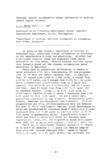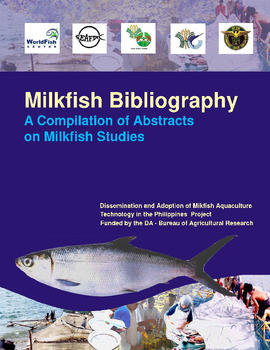Hormonal changes accompanying sexual maturation in milkfish Chanos chanos Forsskal
- Global styles
- MLA
- Vancouver
- Elsevier - Harvard
- APA
- Help

View/
Date
1987Page views
5,391ASFA keyword
AGROVOC keyword
Taxonomic term
Metadata
Show full item record
Share
Abstract
In spite of the economic importance of milkfish to the Southeast Asia, relatively little information is available on its reproductive biology and physiology. Milkfish has a prolonged juvenile phase undergoes first sexual maturation at five years. Steroid hormone profiles during this juvenile phase and the change accompanying sexual maturation is described.
There were no significant differences in levels of serum estradiol 17-B (E2), testoterone (T) and progestrone (P) of male and female immature fish. In immature fish, E2 ranfed from 0.145 to 0.600 ng/ml, T varied from 2.04 to 3.75 ng/ml, and P ranged from 0.472 to 1.16 ng/ml. Serum T, however, was significantly high in 4 years old immature fish fish while E2 was significantly high in 2 years old fish. Mean E2 level rose from 0.54 ± 0.11 ng/ml (E2) in immature female (Stage 1) to 4.53 ± 1.16 ng/ml in vitellogenic females (Stage 5) while T increased from 2.06± 0.28 ng/ml to 38.4± 9.26 ng/ml. E2 and T levels were positively correlated to egg diameter. Progesterone level, however, remained low through vitellogenesis. 17-a-OH-progesterone and 17-a, 20-B-progesterone were not detectable even in fully vitellogenic females. Gonade development in males was sccompanied by increase serum T levels only. T levels increase from 2.5± 0.40 ng/ml in immature males to 27.73± 5.02 ng/ml in spermeating males. Significantly higher T level was found in males with thick but abundant milt (spermiation index, SPI, 2+ ) compared to males with scanty milt (SPI, 1+) or mals with copious, fluid milt (SPI, 3+).
Ther was no significant seasonal variation in levels of E2 and T of immuture 3-5 years old female sampled from july 1981 through February 19083. Serum E2 varied from 0.125 ng/ml to 1.45 ng/ml while T was uniformly low and ranged from 1.16 ng/ml tp 2.07 ng/ml. The levels of E2 and T significantly rose during the breeding season (April-June, 1983)and accompanied the increase in gonadosomatic index (GSI) aat this time (E2, 3.43± 0.49 ng/ml; T, 40.04± 16.20 ng/ml ). The levels of both steroids dropped to below 1 ng/ml in spent females sampled in the succeeding months. In immature males, mean serum E2 was beolw 1 ng/ml through except for a significan high level (2.36 ng/ml ) found in 3 years old male sampled in October to December, 1981 while T levels ranged from 1.11 ng/ml to 2.78 ng/ml. As in females, T levels significantly rose to 21.52± 8.38 ng/ml during the breding season when GSI peaked (April-June ,1983). E2 remained low throughout. T level dropped to arround 10 ng/ml in the succeeding months when spent or regressed fish were samlped
Description
Abstract only.
Type
Conference paperCollections
- Conference Proceedings [299]
Related items
Showing items related by title, author, creator and subject.
-
Milkfish bibliography: a compilation of abstracts on milkfish studies
WorldFish Center (WorldFish Center, 2007)Milkfish Bibliography covers 700 references on milkfish biology; broodstock management and fry, fingerling and egg collection and production; milkfish culture systems; health and nutrition; post harvest technology; ... -
Ongoing research studies on maturation and spawning of milkfish, Chanos chanos at the brackishwater shrimp and milkfish culture applied research and training project, Jepara, Indonesia
Alikunhi, K. H. (Aquaculture Department, Southeast Asian Fisheries Development Center, 1976)The paper gives an account of the research work carried out at Jepara, Indonesia, on induction of maturity of milkfish in ponds and enclosures, and procurement of the spawners from the wild for seed production by hypophysation. ... -
Ration reduction, integrated multitrophic aquaculture (milkfish-seaweed-sea cucumber) and value-added products to improve incomes and reduce the ecological footprint of milkfish culture in the Philippines
de Jesus-Ayson, Evelyn Grace T.; Borski, Russel J. (AquaFish Collaborative Research Support Program, Oregon State University, 2012)In the Philippines, cage culture of milkfish in marine environments is increasing. The practice uses high stocking densities, with significantly greater inputs of artificial feeds which more often than not, have led to ...





